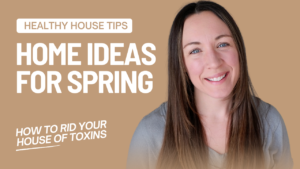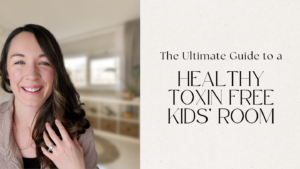
Phthalates is a bit of a buzzword in the health and wellness community, but what are phthalates, anyways? We know they’re a toxin, but do we know what makes them a toxin, and do we know HOW they affect our bodies?
I was shocked to learn more about phthalates as I wondered myself what are phthalates even in? I found out quickly that this man made chemical is EVERYWHERE. It’s in our kitchens, in our water pipes, in our flooring and in our kids toys and clothes. In fact, a study done even confirmed that 100% of house dust contains phthalates.
That’s when I had to put the brakes on and remind myself that while this is an awful toxin that I want to try to avoid, it’s a big one, and I can’t go about replacing everything within my home that may contain phthalates.
It was another good reminder that I had to start slow and just replace one thing at a time. This concept has helped me stay so grounded while I have worked slowly, but diligently to make healthier choices within my home and for my family. This post about your mindset when it comes to your home is exceptionally helpful if you’re feeling overwhelmed about replacing items and products.
So I encourage you to keep this in mind as we talk about the sheer number of items that phthalates are in at home. Let’s take a look at “what are phthalates.”
WHAT ARE PHTHALATES?
Sometimes called plasticizers, we often wonder, “What are phthalates?” Phthalates are a group of chemicals essentially that are very difficult to break apart and are fairly flexible. HUNDREDS or products use phthalates, and they range widely from vinyl flooring to personal care products to kids toys.
Phthalates are colorless, odorless and used in products that are long lasting and durable. Think flooring, rain boots, — basically anything that’s going to have to be durable enough to withstand moisture and scratching.
If you’re wondering what are phthalates good for, basically, they make all of these products bendable, flexible and strong.
This report on pthalates is EXTREMELY in-depth and informative, and the basis for a lot of my blog post if you’re a reader.
One of the largest problems with phthalates is they are highly unregulated and the exposure is incredibly frequent. This means at times we may not even know what our children and ourselves are being exposed to in terms of toxins.
And another large problem with phthalates is that it builds in our system as we are exposed to more and more of it. The toxicity levels increase with each exposure and our body becomes burdened by this toxin, causing poor health effects. (STUDY)

WHERE ARE PHTHALATES FOUND?
What are phthalates used for? SO many things, currently. You could probably start counting up the items in your home that contain phthalates based on this list below:
- Plastic and vinyl toys
- Vinyl flooring
- Shower curtains
- Food packaging and wrap
- Detergents
- Plastic water pipes
- Cosmetic and personal care products
- Wallpaper
- Miniblinds
- Raincoats
- Cleaning Products
- Vinyl Gloves for Handling Food
- Furniture Upholstery
- Garden Hoses
- Wire Cabling
Phthalate exposure happens when we ingest food or water that is packaged in plastic. Children can ingest phthalates when they chew on soft vinyl or plastic toys.
You can also breathe in phthalates. This is most common when there is a fixed item in your home that contains phthalates. If we look at the list above, you could deduce that flooring, mini blinds, wallpaper and shower curtains could be big culprits here. The particles from these end up in our dust and we then breathe in the toxin.
And as I shared earlier, 100% of house dust contains phthalates (STUDY).
Finally, you can have skin contact with phthalates by touching them or wearing them in a product.

When you’re looking to identify phthalates and trying to find out what are phthalates in, this little list will be your BEST friend:
- BBP: butyl benzyl phthalate
- MBzP: mono benzyl phthalate
- DBP: di-n-butyl phthalate
- MBP: mono-n-butyl phthalate
- MiBP: mono-isobutyl phthalate
- Most common phthalate added to nail polish.
- DEHP: di-(2-ethylhexyl) phthalate
- MEHP: mono-(2-ethylhexyl) phthalate
- Most widely-added phthalate to polyvinyl chloride (PVC) to make products flexible.
- DEP: diethyl phthalate
- MEP: monoethyl phthalate
- Most common phthalate added to personal care products to enhance fragrance.
- DiDP: di-isodecyl phthalate
- DiNP: di-isononyll phthalate
- Most common phthalate added as a softener in the manufacture of toys and childcare products, such as bath toys, drinking straws, and rubber ducks.
- DnHP: di-n- hexyl phthalate
- DnOP: di-n-octyl phthalate
HEALTH EFFECTS OF PHTHALATES
Phthalates, as with many of the toxins we come across are more toxic to children in comparison to adults. In the case of phthalates, this is because many children’s toys contain phthalates, especially toys that end up in their mouths. This poor hand to mouth habit is also another way children ingest more phthalates. It’s also important to remember that kids are often given plastic plates, cups and utensils to eat on, heightening their risk again.
In children, their exposure is often WELL over the EPA’s allotted limit. (STUDY) Studies also show that prenatal exposure to phthalates is linked with the worst health outcomes in children and newborns.
Phthalate exposure has been linked to abnormal reproductive development as well as neurological toxicity in kids and adults. (STUDY)
Some phthalates are also known endocrine disruptors, meaning they hinder our natural hormone production and can in turn cause issues with thyroids, immune system and the reproductive process (STUDY)
An in-depth study also states, “Recent studies also show that prenatal exposure to phthalates is associated with adverse impacts on neurodevelopment, including lower IQ, and problems with attention and hyperactivity, and poorer social communication. ” (SOURCE)
HOW TO FIND PRODUCTS THAT ARE PHTHALATE FREE
Besides using the list of ingredient codes above, another great way to find products that are phthalate free is to look at the label for recycling. Avoid the products that have the recycling sign with a number three in the middle. Often the have either a letter “V” or “PVC” underneath the arrows.
I also recently wrote up a helpful post showing how to use Target’s new search feature to find products that are phthalate free in their stores.
You could also use the Think Dirty App when you are looking for personal care items.
Mighty Nest is another place that I LOVE to look when I’m on the hunt for something healthy and something that I need to swap out of my house. They have SO many options when it comes to plastic free items.
Here are some of my favorite swaps for the other big offenders listed above:

Just remember that ANY way you can reduce phthalates in your home is beneficial to your body. Remember our exposure is frequent with this toxin, and so reducing even just small amounts can have a HUGE impact to our body.
Share this:
- Click to share on Facebook (Opens in new window) Facebook
- Click to share on LinkedIn (Opens in new window) LinkedIn
- Click to share on Reddit (Opens in new window) Reddit
- Click to share on Pinterest (Opens in new window) Pinterest
- Click to print (Opens in new window) Print
- Click to share on X (Opens in new window) X





Pingback: Plastic Free & Toxin Free Organizing Ideas » Healthy House on the Block
Pingback: Organic Bath Towels, Kitchen Towels & Turkish Towels »
Pingback: Healthy Homes Create Healthy Kids
Pingback: Frequently Dirty Air Filter? Air Duct Cleaning is the Answers - Healthy House on the Block
Pingback: Toxin Free Isn’t Attainable: Toxins in a Healthy Home - Healthy House on the Block
Pingback: Natural and Organic Bedding Guide - Healthy House on the Block
Pingback: Healthy Windows: Best Windows | Toxin Free Blinds | Organic Curtains - Healthy House on the Block
Pingback: Identify Toxic Materials: Avoiding Sick Building Syndrome
Pingback: Best Toys for a Healthy Home and Healthy Kids -
Pingback: Preventing Allergies and Asthma Symptoms in Kids